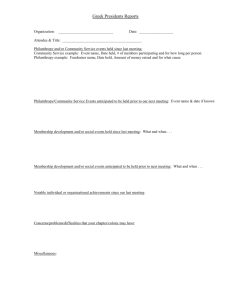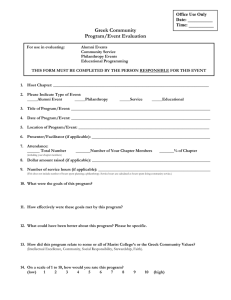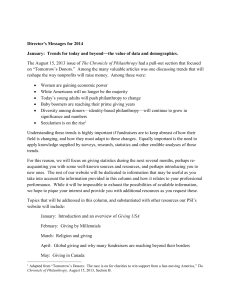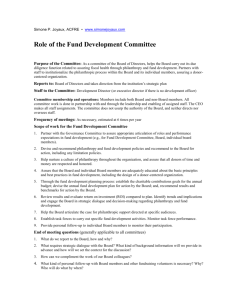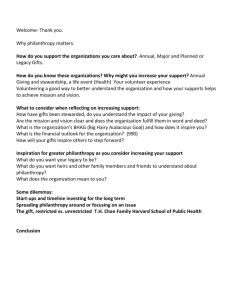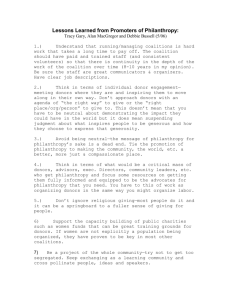Hyperagency and High-Tech Donors: A New Theory of the New Philanthropists
advertisement
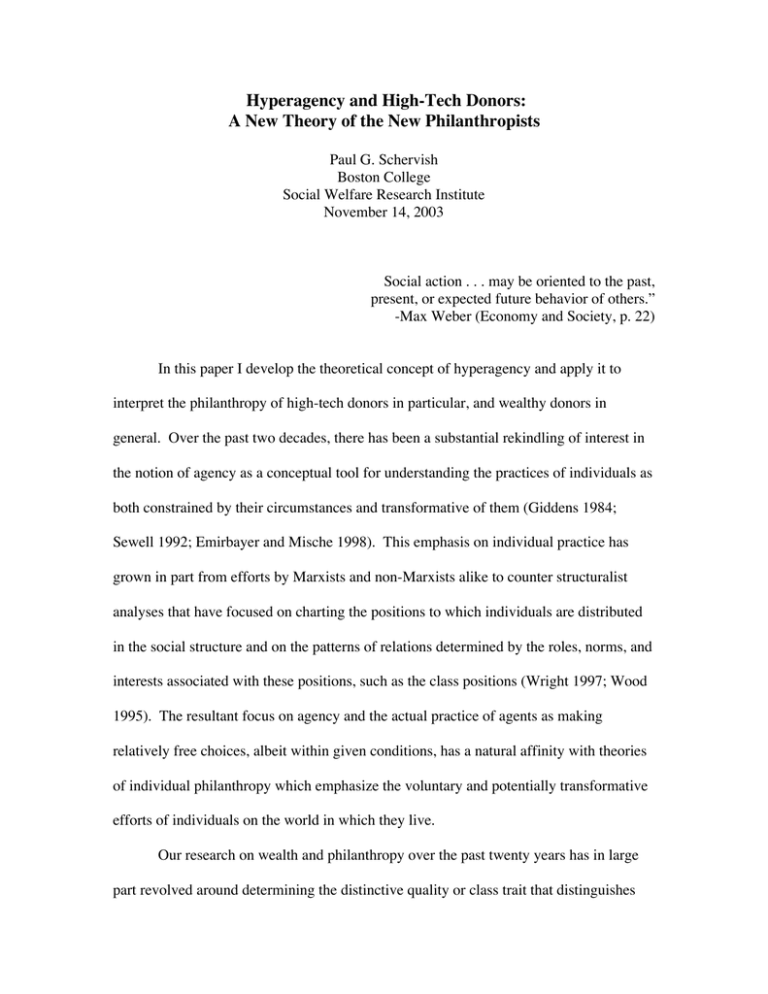
Hyperagency and High-Tech Donors: A New Theory of the New Philanthropists Paul G. Schervish Boston College Social Welfare Research Institute November 14, 2003 Social action . . . may be oriented to the past, present, or expected future behavior of others.” -Max Weber (Economy and Society, p. 22) In this paper I develop the theoretical concept of hyperagency and apply it to interpret the philanthropy of high-tech donors in particular, and wealthy donors in general. Over the past two decades, there has been a substantial rekindling of interest in the notion of agency as a conceptual tool for understanding the practices of individuals as both constrained by their circumstances and transformative of them (Giddens 1984; Sewell 1992; Emirbayer and Mische 1998). This emphasis on individual practice has grown in part from efforts by Marxists and non-Marxists alike to counter structuralist analyses that have focused on charting the positions to which individuals are distributed in the social structure and on the patterns of relations determined by the roles, norms, and interests associated with these positions, such as the class positions (Wright 1997; Wood 1995). The resultant focus on agency and the actual practice of agents as making relatively free choices, albeit within given conditions, has a natural affinity with theories of individual philanthropy which emphasize the voluntary and potentially transformative efforts of individuals on the world in which they live. Our research on wealth and philanthropy over the past twenty years has in large part revolved around determining the distinctive quality or class trait that distinguishes 2 the empowerment of wealth holders in realms of business and politics, as well as lifestyle and philanthropy (Schervish et. al 1994; Schervish 1997). Our finding is that at least in the material realm, the class trait of wealth holders is hyperagency, which I define as the array of dispositions and capacities that enable individuals to relatively singlehandedly produce the social outcomes they desire, as well as the conditions within which they and others exercise their agency. If agency is the capacity to make choices largely within the rules and resources that are socially given, hyperagency is the capacity to be a creator or producer of those rules and resources. If agents are finders of the most desirable or fitting place for themselves within a limited range of possibilities, hyperagents are founders of those possibilities for themselves, as well as for others. What takes the aid of a social, political, religious, or philanthropic movement for agents to achieve, can be achieved by hyperagents pretty much single-handedly. Although to this point I have developed and employed a rudimentary notion of hyperagency in our studies on wealth and philanthropy, I have not systematically connected it to the theoretical literature on agency or used it as the fundamental explanatory concept for an extended study of giving patterns by wealth holders. It is my intention to take up each of these issues in this paper. In the first section of the paper, I draw on the sociological literature to identify those aspects of the theory of agency in so far as they are relevant to elaborating a general understanding of hyperagency (Emirbayer and Mische 1998; Alexander 1992; Archer 1982; Coleman 1990; Turner 1994). In the second section I elaborate the meaning of hyperagency as a distinctive kind of agency with specific dispositions and capacities. In the third section, I use this developed notion of hyperagency as the principal interpretative concept for analyzing the dispositions and 3 practices that high-tech donors manifest in business and philanthropy. In the conclusion, I indicate the implications of the research for the understanding of hyperagency, the new philanthropists, the new horizons of philanthropy in general, and of fundraising. In developing and demonstrating the workings of hyperagency, I draw on the findings from the 2001 High-Tech Donors Study, which was carried out by the Boston College Social Welfare Research Institute, January through March 2001 (Schervish et. al 2001). The leading questions of the research revolved around discerning: first, the relationship between how high-tech wealth holders accumulate their money in business and how they allocate it to philanthropy; second, the range of personal, business, and philanthropic issues that surround high-tech wealth and philanthropy; third, the implications of the findings for understanding and improving the trajectory of the philanthropy carried out by high-tech donors; and fourth, the application of what I would learn to further our understanding of the emerging problems and prospects of philanthropy in general. The research was conducted on behalf of the Association of Fundraising Professionals (formerly the National Society of Fund Raising Executives); and was initiated and funded by Dr. Robert B. Pamplin, Jr., President and CEO of the R.B. Pamplin Corporation in Portland, Oregon. Sociological Considerations of Agency 4 In this paper prepared for presentation at the ARNOVA conference I review only briefly some of the major directions in the literature on agency and will move rather directly to the synthesis of my positive theory of agency and hyperagency. Significant strides have been made in transcending the social structure/human agency antimony by figures such as Bourdieu (1984) and especially by Giddens (1979, 1984) in his conception of the "duality of structure,” and by Emirbayer and Mische (1998) in their comprehensive recasting of the For Giddens in his theory of structuration, social structure has only a "virtual" existence, existing only at moments in time and space when embodied by individual agents endowed with a relatively high degree of reflexive self-consciousness. On the other hand, agency cannot take place without the rules and resources of structure which both enable and constrain individual and collective agency. According to Giddens, structure is dual because it is both the medium and outcome of agency. Structuration theory embraces this notion of duality in order to accentuate the creative and transformative potential of human agency in relation to institutional existence. For Giddens, agency is thus the purposeful practice of individual actors that occurs in the context of acknowledged and unacknowledged conditions and produces intended and unintended consequences. Agency is the strategic practice of individuals in which they exercise power or capacity to accomplish transformative reproduction. In other words, agency is the practice of individuals that begins in given structural conditions and results in transformative reproduction of structural outcomes. Giddens’s insists on the notion of transformative reproduction in order to denote that it is impossible for an act of agency to simply reproduce the past since every action is unique in time and space and environment. At the same time, no act of agency can ever be completely 5 transformative, since any change remains organically connected to its origins in time and space. A second significant contribution to understanding agency is that of Emirbayer and Mische (1998) who provide what they call a chordal triad of agency focusing on the past, present, and future—not unlike Giddens’s triad of structural conditions, agency, and structural outcomes. Emirbayer and Mische define agency “as the temporally constructed engagement by actors of different structural environments—the temporalrelational contexts of action—which, through the interplay of habit, imagination, and judgment, both reproduces and transforms those structures in interactive response to the problems posed by changing historical situations” (authors’ emphasis) (p. 970). The first aspect of the chordal triad is the iterational element which relates to how agents relate to the past: “It refers to the selective reactivation by actors of past patterns of thought and action, as routinely incorporated in practical activity, thereby giving stability and order to social universes and helping to sustain identities, interactions, and institutions over time” (authors’ emphasis) (p. 971). The second aspect is the projective element, akin to Giddens’s notion of strategic conduct oriented toward creating the future: “ Projectivity encompasses the imaginative generation by actors of possible future trajectories of action, in which received structures of thought and action may be creatively reconfigured in relation to actors’ hopes, fears, and desires for the future” p. 971). Finally, the aspect of agency that relates to the present is the practical evaluative element: the capacity of actors to make practical and normative judgments among alternative possible trajectories of action, in response to the emerging demands, dilemmas, and ambiguities of presently evolving situations” (authors’ emphasis) (p. 971). 6 I agree with Emirbayer and Mische that of the three elements, the most neglected has been the projective element. Both Giddens's work and others have tended to speak more about, even if not theoretically privileging , the aspects of social structure that condition agency. They stress how agents within the medium of structure reproduce that structure; or, in other words, how the structure serves as a set of constraints and enablements that limit and empower the voluntaristic instrumentality of agents. The transformative or formative aspects of agency are not absent from the theory, but those aspects are not as emphasized as the rules and resources of structure that precede and condition agency. Drawing on Giddens and Emirbayer and Mische, my understanding of agency is that it is the array of strategic practices by which an actor closes the gap between the past and the future. For me starting point for a broader synthetic understanding philanthropy as agency resides in Aristotle’s broad discussion of the relation of choice and virtue in his Nicomachean Ethics (1999). Aristotle says that the goal of life is happiness and implies that happiness is achieved by closing the gap between where one is and where one wants to be. This gap is closed by making choices which are, at their normative best, what he would consider to be permeated with an educated wisdom serving as the basis for wise choices. Agency, then, is the set of practices that implement the possible choices facing agents and that constitute a perpetual migration from genesis to telesis, from history to aspiration. Wise choices, insists Aristotle, require both the freedom to act voluntarily and the virtue of wisdom. There can be no virtue without freedom; and no true freedom without virtue. Without capacity there is no possibility of choice, just as without virtue there is no possibility of directing capacity. Making wise choices is thus the practice of 7 moral agency, the combination of capacity and character or moral compass. Notice, that here I do not give any particular content to what constitutes wisdom or a wise choice. But if wisdom is understood as a sensitized or conscientious normative orientation, the term is akin to what Emile Durkheim means by morally oriented behavior which he and others at the dawn of sociology derived from the Latin mores meaning the customs, traditions, or value-laden normative currents that provide the frameworks and aspirations for agency. In my schema, then, agency is the implementation of practical-evaluative choices in the light of iterational conditions and directed toward a projectivity of aspiration. In a word, agency revolves around genesis, telesis, and choice—what Emirbayer and Mische call routine, purpose, and judgment (p. 963). In regard to the past, agency is situated within the conditions comprised of normative and existential frameworks of thinking, feeling, and acting; and comprised of human and material resources (Giddens, 1984; Sewell 1992). In turn, agency is directed toward accomplishing one’s normative and utopian frameworks; and toward creating new distributions or orders of human and material resources. Agency is the realm of human causal practice of choice that draws on genetic or starting conditions (personal and social) of capacity and moral foundation in order to generate teletic outcomes (personal and social) of capacity and moral aspiration. Hyperagency 8 I have already indicated that most work on agency revolves around issues of the past rather than to the future—what Emirbayer and Mische say is the domain in which social actors “construct changing images of where they think they are going, where they want to go, and how they can get there from where they are at present” (p. 984). This is exceptionally important because of the theoretical bias against seeing how even wealth holders and other endowed or capacitated actors are engaged in builders of a new dispensation. For instance, Abercrombie, Hill, and Turner in their books The Dominant Ideology Thesis and The Sovereign Individuals of Capitalism argue that there is a relative autonomy of discourse and ideology from economic practice. In the terms of Emirbayer and Mische, Abercrombie, Hill, and Turner would say that despite any internal or external discourse individuals may express in regard to where they are and where they want to go, the constraints of economic structure, in particular advanced capitalism, soundly limit the possibility of actually creating alternative futures. In particular, they claim that there is no necessary connection between the ideology of individualism, on the one hand, and the actual workings of capitalism and the characteristics of economic subjects who work within it. In essence, in their second book they argue that the increasingly bureaucratic nature of advanced capitalism contradicts the ideological discourse of individualism and individual efficaciousness that maintains that empowered autonomous individuals are able to personify themselves through purposive social practices. They conclude that even though a vision of sovereign individualism dominates the ideology of western capitalism, no such individualism exists in either the dominant or subordinate classes. 9 In contrast, I argue that the wealth holders sovereign individuals capable of incarnating their aspirations and expectations into actual practices and organizational forms. In fact all individuals as Giddens (1984) insists are in certain circumstances and under certain conditions capable of shaping outcomes through agency—especially when amalgamate in social, cultural, and political movements. While recognizing that all individuals are not equally capable of a socially or culturally formative agency, I do maintain that certain individuals, those imbued with a certain material and psychological capacity, are clearly able to shape alternative futures not just for themselves but for others as well. These particularly endowed agents capable of implementing their projectivity are what I call hyperagents. Although not all hyperagents need be wealth holders (for instance, saints and poets, as Wilder reminds us in Our Town), all wealth holders are, when and where they choose, capable of exercising lesser or greater degrees of hyperagency. Wealth holders are uniquely endowed with material resources and cognitive dispositions that enable them, both as a group and as individuals, to fashion outcomes they desire to effect . Wealth grants a special capacity for empowerment. Whereas all individuals exercise agency, the distinctive class trait of hyperagency is the capacity to establish rather than merely receive the social matrix within which they live. The wealthy construct a worldly realm of principality in time and space and an inner domain of individuality. As such, hyperagency is distinctive moral identity in addition to sustaining a formative practice. Hyperagency is privileged position in the process of structuration, as Giddens puts the process by which agents are situated within structural conditions and via agency carry out reproductive transformation of those conditions. Hyperagents, in contrast to agents 10 are not only have greater command over the frameworks and resources comprising the structural conditions but also over shaping the frameworks and resources that comprise the structural outcomes. It is not that hyperagent can single-handedly and completely transform the entire world around them. But that they can and do carry out the transformative moment of structuration as a matter of course in their daily practices of business, family, consumption, politics, and philanthropy, Elements of Hyperagency—Realms of Capacity and Moral Compass In Gospels of Wealth (Schervish, Coutsoukis, and Lewis, 1994), I described three inter-related components of the capacities that constitute the genetic resources which hyperagents draw on in exercising their productive agency. These are (1) psychological empowerment—the disposition of great expectations, the legitimacy of those expectations, and the confidence to achieve them; (2) spatial empowerment—the capacity to establish a protective wall from intrusion and to extend one’s influence geographically beyond one’s immediate personal presence; and (3) temporal empowerment—the ability to reshape the past, forge the present, and bind the future. Clearly, such capacity does not guarantee that hyperagents will make wise productive decisions and generate an offspring of benefit for themselves and others. It does, however, guarantee that such individuals will possess a broad horizon of choice, that their choices will have the capacity to fashion the choices of others, and that their agency will advance or impede the teletic ends of themselves and others. 11 In addition to exercising the foregoing resources, productive agency brings to bear normative and existential frameworks that direct the use of their resources. In Gospels of Wealth (1994), I also described three inter-related aspects of normative orientation that come into play to order hyperagents’ productive empowerment : (1) the daily exercise of what is conceived to be virtue or strength of character that directs how hyperagents work with the opportunities and obstacles of the hand that life has dealt them; (2) the special exercise of character that is required to face tests of moral fiber that occur as individuals move through formative life-course transitions from one social status and personal identity to another; and (3) the impulse to make the big and small events of biography a redemptive process of life, death, and rebirth in the quest for healing, learning, forgiveness, and union. The quotidian exercise of virtue, dutiful commitment during transitions, and the quest for transformation are the aspects of moral orientation, when married to psychological, spatial, and temporal empowerment, comprise the general framework of meaning and practice of agency—and when exercised in a institutionally formative manner, in a productive rather than participative effort, they constitute the meaning and practice of hyperagency. Hyperagency and High-Tech Donors 12 I now turn to explaining the underlying material and dispositional capacity of effectiveness—what I call hyperagency—that undergirds the hyperagent-animated character of high-tech donors, which they garner from their commercial dealings and translate to their philanthropy. When coupled to the dynamics of gratitude, identification and association, world-building does not stop at the doors to their homes or their businesses, but extends to all their involvements including, for those who choose, politics, community, religion, and philanthropy. The wealthy are by dint of personality no more egoistically myopic or socially responsible than anyone else. Great expectations and grand aspirations occupy people across the financial spectrum. What is different for wealth holders is that they can be more legitimately confident about actualizing their expectations and aspirations because they are able to directly effect the fulfillment of their desires. A retired Hewlett-Packard executive (all identifying information has been changed) voices the kind of can-do productive disposition that psychological empowerment affords: I think for young high-tech entrepreneurs getting involved in a start-up it's the excitement of being able to work in a small, agile, nimble place that can sort of say, hey, let’s go do something in kind of a swat team way and go see it done because that had been their professional experience. . . . So these people’s professional experiences, hey you get together a group of twenty to forty people, you see some product that needs to be done, you go off and make it, it’s on the shelf two years later, you’ve had this huge impact, and I think that that’s, that is the mentality that they bring to philanthropy as well. 13 That high-tech donors are hyperagents in philanthropy does not mean that they always and everywhere conceive of or achieve major innovative interventions. It does mean that they tend to think more about doing so, and partake more in actualizing them, as the retired co-founder of an internet communications company says. “I'm a big believer now that your visions and your goals can happen if you actually take time to think about what you want them to be. I'm a big believer in writing them down and they tend to become reality because you start taking the steps to get there.” Hyperagents act in philanthropy with two defining aspects of entrepreneurship. First they identify a creative idea: they discern an area of output for which demand outstrips supply. Second, entrepreneurs actively affect the rate of return on their investment by directly commanding production. The distinctive class trait of the hightech donors is their ability to bring into being, not just support, particular charitable projects. Hyperagency in the field of philanthropy assigns financial resources to fashioning major outcomes. When exercising this capacity, high-tech donors are producers rather than supporters of philanthropy, underwriters rather than just contributors. Finding neglected social niches where needs are great and resources scarce is precisely the explicit strategy of many respondents whom we interviewed. This attitude of identifying and accomplishing an aspiration through their own efforts is evinced by virtually all high-tech donors. One West Coast former Hewlett-Packard executive talks about how “inspiring” it was to salvage a conservation initiative which had fallen through. “All these people who had been working on it were so despondent,” 14 he says speaking about the organization of individual who had attempted to buy up some forest land. But armed with the psychological empowerment of great expectations and the material wherewithal to create a temporal-spatial principality, this hyperagent had a plan and a capacity to achieve it the non hyperagents found hard to believe. “Well why don’t we just try to go raise this money privately,” he told them; “and they said, ‘look, nobody’s ever raised $13 million for private land, for a land conservation effort before and we did it in like three months’” without success. But for him possible and rewarding: “It was just very empowering and motivating to see how basically overnight we could protect such a huge area, protect the lynx population, and so forth; it was pretty inspiring.” Furthermore, this philanthropy turnaround specialist ascribes his fundraising success to his own ability to get things done and to enlist other hyperagent who share that disposition. He and all those he enlisted to secure the needed $13 million, he says, “all come from a business that was this really empowering business where you could go decide to do something, and two years later there will be some product that will be used in every company in the world. . . . [These] people sort of believe that ‘oh, well I can just go out and do something and then at the end this will essentially be sort of a product.’ They don’t have this feeling of change takes a long time.” And this extends to philanthropy as well. “So when you go to these people and say, ‘give us your money and at the end of a year or two, you will have personally, along with a hundred other people, helped protect these 25,000 acres and the lynx population, and you’ll have done something, and essentially there will have been a product that you will have produced,’ 15 they get that instantly. There wasn’t any hesitancy about it – they said ‘cool, that’s what I’ll do.’ In common parlance we regularly speak of donors and major donors. Distinguishing between supporters and producers of philanthropy is a more functional distinction. Each philanthropic enterprise pursues resources in order to produce outcomes in response to social needs and interests. Most individuals respond to appeals for contributions in a manner similar to the way a consumer responds to the products or services of a business. They are just one person among a far larger pool of actors. They do not individually have enough buying power to have a firm create a product for them; nor do they single-handedly have enough giving power to be create or re direct the charitable enterprise to which they contribute. Only as a group acting formally or informally in concert, can everyday contributors fashion the fate or mission of a charitable enterprise. Because it is the accumulated support of many individuals, rather than of any particular single individual, that determines the existence and direction of a venture, individuals with only modest resources are at most joint or collateral producers. It is a different story altogether when high-tech donors contribute a sizable enough gift to actually shape the agenda of a charity or nonprofit institution. In this instance, the contributor may be termed a direct producer or architect. Such direct production, of course, cuts two ways, and so it is always important to discern the conditions under which philanthropic hyperagency produces care rather than control, as we will discuss later. The extreme case of direct production in philanthropy is the personal founding of an original philanthropic organization or project. We heard several instances of how 16 high-tech donors either have or plan to create a private or working foundation. One respondent has begun to work on elevating teachers’ salaries by providing the money to do so in one school, in the hope that the positive effect will spillover as pressure on surrounding schools to do likewise. Another respondent explains that his dream sometime in the next five years is to endow a foundation that will supply the funds to raise teachers’ salaries in the inner city of his hometown where he attended school in a more advantageous time. Less formally, another high-tech donor produced the philanthropic outcome by financially “adopting” a niece with Downs' syndrome. And still another provides substantial enough gifts to all his and his wife’s siblings to provide a level of financial security that will liberate them to make choices in their lives based on a desire for significance rather than on a need for income. Whether formally or informally, at a distance or close to home, it is the possibility and practice of “making a difference” that undergirds the determination and dominion of high-tech philanthropists. Such hyperagency infuses all the philanthropic endeavors of high-tech donors, but it shows up in particular in three forms of what we call intercessional philanthropy. Varieties of Intercessional Philanthropy Strictly speaking, “venture capital,” the term that spawned the analogous “venture philanthropy,” denotes the more or less active dedication of an investor’s money and expertise and sometimes direct involvement to propel an entrepreneurial activity initiated by someone else. But as the term has come to be associated with philanthropy it refers to a range of approaches that are in fact more widespread and multifaceted than what is strictly parallel to venture capital in the business world. We find that much of what is 17 regularly included within the category of venture philanthropy is more accurately called managerial philanthropy or entrepreneurial philanthropy. Managerial philanthropy is the contribution of organizational expertise without the contribution of financial resources to elevate the effectiveness of a charitable organization. One example is the respondent, whose wealth is mainly tied up in a Silicon Valley Internet start-up. She contributes some money but much managerial expertise to her alma mater, Stanford University, to help with fundraising and to develop better fundraising methods. A more extensive statement of this managerial strategy is provided by a former software entrepreneur: What I felt was my greatest strength is the managerial side. I can manage people, I understand how people work, I don't try to categorize them all the same and I understand the differences. Pure entrepreneurs are typically pretty horrible managers because they want everything to happen in five seconds, they don't understand why everything can't be done in thirty seconds. Why isn't everybody as smart, if you will, why doesn't everybody see it like them, and then they just want to put their foot right on the accelerator and go as fast as they can. And I have some of those tendencies, but I have the ability to know that there's a brake as well and I know when to use it. Entrepreneurial philanthropy is the joint contribution of both human and financial capital of a wealth holder to inaugurate either a new charitable enterprise or a new 18 component within an existing charity. For instance, there is the Austin high-tech entrepreneur who expends the majority of his philanthropic dollars and time overseeing his entrepreneurial start-up of a charity dedicated to overcoming the digital divide facing urban youth. A fuller example is offered by a self-described social entrepreneur who is starting his own charity: To me an entrepreneur and a social entrepreneur is someone who looks at something that doesn’t exist and says why can’t it exist, as opposed to someone who looks at something and says that can’t happen. An entrepreneur to me is someone who is willing to create something from nothing, who is willing to go in and get your hands dirty, and make change happen and instigate change, and create new ideas or institutions or organizations, and get a return on that investment of time and energy and effort made. The social return is measured perhaps in community capital or human capital or social capital. It just happens not to be measured in financial capital, but it is still the same entrepreneurial instincts and drive which happens to be focused on the social sector. In my view, venture philanthropy is that “middle” form that infuses managerial advice and financial resources into a philanthropic effort, but does not interject the handson daily direction that is the hallmark of an entrepreneur. Here I place the Boston software entrepreneur, who has started his own family foundation, but nonetheless also contributes both money and skills to help others get a charity off the ground by assisting with goal definition, planning, and advice about how to leverage funding. A former 19 software entrepreneur who retired and started his own family foundation provides an example of this middle path of venture philanthropy: There are certainly a lot of techniques and ways of thinking about problems that I have the benefit of from my background that I have discussed with a number of nonprofit organizations. You’d be surprised at the things and ways of making decisions, thinking about problems and ways of planning strategy and things that someone like myself would take for granted. A lot of people in these organizations have never had to think about things that way. So a little advice or insight for how the entrepreneurs approach problems actually goes a long way and helps them quite a bit. I’ll give you an example. I am working with a woman who is starting up a new 501 (c)(3), a new organization. I am making an exception because I am actually going to join her board and help her bootstrap that whole thing. A lot of it has to do with how much I think my assistance can be leveraged. If it’s a situation where I can get in there for an hour a week or over the phone or something like that, have a large impact in helping somebody, it's attractive to me. It’s sort of the work/reward ratio. Also what we’ve done is set up a program with her where we are putting up half of her start-up funding as a matching grant. So that is another example of the entrepreneurial thing. If we put in as a matching grant, you may be able to use that as leverage when you go to other organizations and say, look, this Family Foundation is putting in for half, we need to get the other half and can we count on you. So that’s helpful. 20 In the course of the interviews we discovered so many additional examples of donors pursuing each of these forms that we conclude that carrying out one or more of these intercessional philanthropic strategies is a leading characteristic of high-tech donors. We also conclude that in order to accurately portray what high-tech donors are doing, the conceptual framework for speaking about them needs to be expanded beyond the term “venture philanthropy” so as to highlight the important differences from managerial and entrepreneurial philanthropy. The three approaches are similar in that each entails a practice of organizational leadership and a disposition focused on improving effectiveness. But in order to understand more accurately what high-tech donors are actually doing, and in order to better alert them to the variety of intercessional strategies they may wish to pursue, it is necessary to recognize the differences among managerial, venture, and entrepreneurial philanthropy. Indeed, the future of so-called venture philanthropy or, better of venture philanthropists engaged in various venture partner organizations, is more likely to revolve around entrepreneurial philanthropy to the extent these high-tech donors solidify their wealth, garner more time to pursue their philanthropic purposes, and discover the causes and people on behalf of which they desire to exert their hyperagency. Conclusion This paper has addressed with a new theoretical grounding and application our central finding from almost 20 years of studying wealth holders, namely that the distinctive class 21 trait of wealth holders is their self-formation and history-making capacity of hyperagency. For sure, not every hyperagent is wealthy. Some financially undistinguished folk make history by virtue of being profound, creative, or spiritual. But in the material realm, including charitable contributions, every wealth holder is at least a potential hyperagent. Hyperagency refers to the enhanced capacity of wealthy individuals to establish or control substantially the conditions under which they and others carry out their agency. For most individuals, agency is limited to choosing among and acting within the constraints of those situations in which they find themselves. As monarchs of agency, the wealthy can circumscribe such constraints and, for good or for ill, create for themselves a world more of their own design. As everyday agents, most of us strive to find the best possible place to live or job to hold within a given field of possibilities. As hyperagents, wealth holders—when they choose to do so—can found a broad array of the field of possibilities within which they and others will live and work. Whether inherited or earned, the possession of substantial financial wherewithal provides a range of material choice and a corresponding moral disposition of great expectations which set them apart from other agents in society. If the social meaning of money in general is agency in general, the social meaning of wealth is hyperagency. In one of his more famous statements, Marx said “Men make their own history, but they do not make it as they please; they do not make it under self-selected circumstances, but under circumstances existing already, given and transmitted from the past. The tradition of all dead generations weighs like an nightmare on the brains of the living. For Marx something new was possible in his day—the first truly revolutionary break with the past history of class society. It did not happen, of course, as he 22 envisioned; but part of what he said it would take to shape history is exactly what characterizes hyperagents. That is, those who are “occupied with revolutionizing themselves and things, creating something that did not exist before” must be able to do more than “anxiously conjure up the spirits of the past to their service, borrowing from them names, battle slogans, and costumes in order to present this new scene in world history in time-honored disguise and borrowed language.” They who seek to formatively shape history “cannot take its poetry from the past but only from the future.” Agents are often condemned to conjure the future in thought and word but not to accomplish its content. Hyperagents are different; for them “the content goes beyond the phrase” (The Eighteenth Brumaire of Louis Napoleon). Hyperagents, it turns out, do "make history" for themselves and others. As a social practice of individuals, hyperagency refers to the enhanced capacity of wealthy individuals to exercise effective control over conditions under which they will engage in social action, and additionally, to set the boundaries for the history-making potential of less empowered individuals. High-tech donors are an identifiable contemporary group of Hyperagents; but not everything about them and their philanthropy is as new as many people imply. On a personal level, they join all wealthy donors in feeling a mixture of guilt and gratitude about their good fortune; are mobilized by the full range of charitable motivations from prestige to identification with the fate of others to wanting to make a difference, and must be vigilant about using special capacity for care rather than dominion. Also not novel among high-tech donors, but common to many wealthy philanthropists, currently and in the past, is the application of business principles to philanthropy. Although the language in which high-tech donors characterize their 23 philanthropy is somewhat distinctive, the fact that they often pursue intercessional philanthropy is not unique. We have documented venture philanthropy as early as 1986 as a long-standing approach of many philanthropists, including inheritors of old money and entrepreneurs working in the old economy. Moreover, venture philanthropy is not the only or necessarily primary intercessional strategy; managerial and entrepreneurial philanthropy are in fact equally, if not more prominent. In fact, we found that high-tech donors pursue the whole range of strategies as all wealth holders—from simply writing a check to the United Way, to adopting relatives, to brokering donations, to contributing to the organizations whose services they and their families use, such as religious congregations, schools, and museums. Despite these continuities with other contemporary wealth holders and philanthropists from the past, there are several distinctive traits of high-tech philanthropy today. Their business experience is different from those of small business owners, the professionals, the inherited wealthy, and the shrewd investor. Their formative experiences in the New Economy coupled to their generally young age and velocity of assent to wealth mark them and their philanthropy with a particular set of concerns, attitudes, hopes and snares. We found that as a group, they are explicitly and consistently entrepreneurial hyperagents. They tend to expect and encourage nonprofits to pursue, as a path to achieve their service goals, the business goals of efficiency, strategic thinking, innovation, risk-taking, good management, accountability, measurable goals, and growth in scale. They have confidence in being able to seek out, attack and alleviate social and organizational problems. They are universally imbued with an optimistic, energetic, and problem-solving mentality. They generally believe that education and development of human capital provide the best solutions to society's problems. Of course their self assurance, can-do attitude, and relative inexperience can lead them at times to be arrogant and presumptuous. However, we found only very occasional evidence of such conceit. With only two exceptions, the respondents were patient and 24 forthcoming in their interviews, and overwhelmingly concerned to educate themselves about the needs they might address, and how best to work with others to meet those needs. In tone and practice they were certainly determined, but also experimental in the sense of being seriously concerned about finding the most helpful way to apply their business skills which seemed for the moment to be their best contribution; to consciously figure out and construct a philanthropic identity; to come to terms with affluence, and with the balance of family, business and philanthropy; and to seek out opportunities for self-reflection, association, and identification in order to be most effective in their philanthropy. Never before, we conclude, have so many wealth holders, with such an entrepreneurial experience, at such a young age, with such great wealth, and with so much future time, and in so many arenas been this consciously intercessional, and purposefully self-reflective about their philanthropy. Still, none of this means that they will necessarily be of great service with their philanthropy, because the very same hyperagency that offers a great potential for creating substantial benefit also has the potential for heavy-handed intrusion. The two-edged sword of being intercessional can result, as we said, in both a formidable contribution of care as well as an overbearing assertion of domination. References: Alexander, Jeffrey C. 1992. “Some Remarks on ‘Agency’ in Recent Sociological Theory.” Perspectives (Theory Section Newsletter, American Sociological Association) 15:1-4. Archer, Margaret S. 1982. Culture and Agency: The Place of Culture in Social Theory. Cambridge: Cambridge UP. Coleman, James S. 1990. Foundations of Social Theory. Cambridge, MA: Harvard UP. Emirbayer, Mustafa, and Ann Mische. 1998. “What is Agency?” American Journal of Sociology, 103(4): 962-1023. Giddens, Anthony. 1984. The Constitution of Society: Outline of the Theory of Structuration. Berkeley, CA: U California P. 25 Schervish, Paul G. 1997. "Major Donors, Major Motives: The People and Purposes Behind Major Gifts." New Directions for Philanthropic Fundraising: Developing Major Gifts, 16: 85-112. Schervish, Paul G., Platon Coutsoukis, and Ethan Lewis. 1994. Gospels of Wealth: How the Rich Portray their Lives. Westport, CT: Praeger. Schervish, Paul G., Mary A. O’Herlihy, and John J. Havens. 2001. “Agent Animated Wealth and Philanthropy: The Dynamics of Accumulation and Allocation Among High-Tech Donors." Social Welfare Research Institute, Boston College. Final Report of the 2001 High-Tech Donors Study. Sewell, William H. Jr. 1992. “A Theory of Structure: Duality, Agency, and Transformation.” American Journal of Sociology, 98(1): 1-29. Turner, Stephen. 1994. The Social Theory of Practices: Tradition, Tacit Knowledge, and Presuppositions. Chicago: U Chicago P. Wood, Ellen Meiskins. 1995. Democracy Against Capitalism: Renewing Historical Materialism. Cambridge: Cambridge UP. Wright, Eric Olin. 1997. Class Counts: Comparative Studies in Class Analysis. Cambridge: Cambridge UP.
